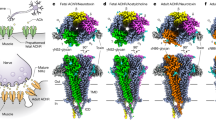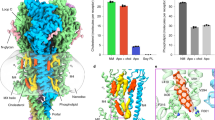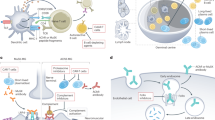Abstract
THE junctional acetylcholine receptors on the motor end-plate mediate the transmission of nerve impulses to skeletal muscle, and their number per endplate is normally kept constant at 1.4–4.7×107 for various vertebrate muscles1–4. In some conditions, as in rats chronically treated with neostigmine5,6 or in myasthenia gravis6, the number of acetylcholine receptors is markedly decreased; whereas, like denervation, insufficiency of neuromuscular transmission caused by various blocking agents, such as hemicholiniurn-3 and β bungarotoxin, tends to increase the number of receptors both at end-plate and non–end-plate zones (C. C. C., S. T. Chuang and M. C. H., unpublished). We, therefore, examined the turnover of acetylcholine receptors at end-plate and non–end-plate zones (extrajunctional) to shed more light on the pathophysiology of skeletal muscle.
This is a preview of subscription content, access via your institution
Access options
Subscribe to this journal
Receive 51 print issues and online access
$199.00 per year
only $3.90 per issue
Buy this article
- Purchase on SpringerLink
- Instant access to full article PDF
Prices may be subject to local taxes which are calculated during checkout
Similar content being viewed by others
References
Miledi, R., and Potter, L. T., Nature, 233, 599 (1971).
Barnard, E. A., Wieckowski, J., and Chiu, T. H., Nature, 234, 207 (1971).
Fambrough, D. M., and Hartzell, H. C., Science, 176, 189 (1972).
Chang, C. C., Chen, T. F., and Chuang, S. T., Br. J. Pharmac., 47, 147 (1973).
Chang, C. C., Chen, T. F., and Chuang, S. T., J. Physiol., Lond., 230, 613 (1973).
Fambrough, D. M., Drachman, D. B., and Satyamurti, S., Science, 182, 293 (1973).
Chang, C. C., and Lee, C. Y., Archs. int. Phamacodyn. Ther., 144, 241 (1963).
Chang, C. C., and Tung, L. H., Eur. J. Pharmac., 26, 386 (1974).
Chang, C. C., Chen, T. F., and Lee, C. Y., J. Pharmac. exp. Ther., 184, 339 (1973).
Berg, D. K., and Hall, Z. W., Science, 184, 473 (1974).
Author information
Authors and Affiliations
Rights and permissions
About this article
Cite this article
CHANG, C., HUANG, M. Turnover of junctional and extrajunctional acetylcholine receptors of the rat diaphragm. Nature 253, 643–644 (1975). https://doi.org/10.1038/253643a0
Received:
Revised:
Published:
Issue date:
DOI: https://doi.org/10.1038/253643a0
This article is cited by
-
Hierarchical chromatin features reveal the toxin production in Bungarus multicinctus
Chinese Medicine (2021)
-
Turnover of acetylcholine receptors at the endplate revisited: novel insights into nerve-dependent behavior
Journal of Muscle Research and Cell Motility (2015)
-
Looking back on the discovery of α-bungarotoxin
Journal of Biomedical Science (1999)
-
Nicotinic receptor-associated 43K protein and progressive stabilization of the postsynaptic membrane
Molecular Neurobiology (1992)
-
Action of anticholinergic receptor antibodies on the frog heart
Bulletin of Experimental Biology and Medicine (1991)



